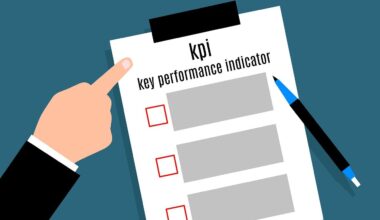How Hyperinflation Impacts Everyday Life and Business
Hyperinflation is an extreme economic event that dramatically decreases the value of currency and significantly affects daily life. It leads to soaring prices, often creating chaos in local economies. When hyperinflation occurs, citizens can witness their purchasing power eroding at an alarming rate. Essentially, this means that people need more money to buy essential goods and services. For businesses, it can be nearly impossible to set stable prices, leading to constant price adjustments. This situation forces consumers to pay exorbitant amounts for basic necessities, which can lead to a breakdown in trust in the monetary system. Additionally, businesses struggle with planning for the future, making investments risky. For instance, companies may slow down production or cut back on hiring. Household budgets become strained as income cannot keep pace with rising costs. Overall, hyperinflation not only disrupts the economy but also instills fear and uncertainty in the daily lives of individuals. Understanding its repercussions is crucial for both citizens and policymakers.
In many hyperinflation scenarios, one notable consequence is the rapid decline in savings. As the value of money diminishes, the savings that individuals have painstakingly accumulated can become worthless in mere days. People may withdraw their savings and convert them into commodities or foreign currencies that hold value. This shift can lead to a black market where essential goods are traded informally. Furthermore, hyperinflation typically leads to reduced consumer confidence. People stop spending money on non-essential items, focusing solely on survival. This behavior can exacerbate the decline of businesses that rely on discretionary spending to thrive. In this environment, only businesses that adapt quickly by offering basic necessities or alternative payment options survive. It’s also common to see a surge in bartering systems as people trade goods directly instead of using currency altogether. Such conditions can create parallel economies in extreme cases, where conventional monetary systems are ineffective. Governments might attempt to stabilize the economy through various means, but these measures often lag behind the quickly shifting landscape of hyperinflation. Effective communication and timely interventions become vital for alleviating the worst effects.
Impact on Employment and Job Security
The job market suffers immensely during periods of hyperinflation. Companies endure significant challenges, leading to layoffs and increased unemployment rates. As costs soar, many businesses are unable to maintain payroll or invest in new hires. The uncertainty surrounding future pricing leads to hesitation among employers to commit to long-term staffing solutions. People may find themselves working multiple jobs just to keep up with rising costs. Consequently, job security becomes a distant concern for many workers. They may also shift their focus toward informal jobs outside traditional employment avenues. This shift creates a volatile labor market, where many workers lack benefits or legal protections. Furthermore, job titles and wages transform rapidly, often resulting in wage adjustments that don’t keep pace with inflation, creating additional financial stress for families. People may turn to freelance work, attempting to capitalize on their skills without relying on a single employer. However, the instability of obtaining regular income can create a cycle of financial insecurity that is hard to escape. Thus, hyperinflation ultimately leads to a comprehensive undercurrent of anxiety affecting both individuals and employers.
The educational sector is also deeply impacted by hyperinflation. Schools struggle to manage budgets that become increasingly inadequate to meet the needs of students. Teachers may experience pay cuts, affecting their ability to maintain morale and quality of education. Families feeling the pressure of rising costs might choose to withdraw children from school, opting instead for informal or unregulated education models. This shift risks creating a generation that lacks access to proper education. Moreover, educational institutions may be forced to increase tuition fees to cope with rising operational costs, making schooling less accessible for many. When uncertainty reigns for families, investing in long-term education becomes a lower priority compared to immediate survival needs like food and shelter. In some regions, educational commodities, including books and supplies, face dramatic price hikes, further complicating attendance and learning. Community initiatives aimed at providing educational resources often struggle to keep pace with hyperinflation. When financing education and infrastructure becomes increasingly tenuous, the very fabric of society and development may shift, undermining progress. Education funding, thus, needs extraordinary focus to stabilize future generations.
Health and Wellbeing Challenges
Health care systems during hyperinflation face enormous disruptions that affect the population’s overall well-being. Hospitals and clinics often operate under immense strain, struggling to procure essential medications and supplies. The inability to afford healthcare leads to increased suffering, particularly for vulnerable populations such as the elderly or those with chronic conditions. This situation typically results in higher mortality rates and decreased life expectancy. As inflation escalates, many healthcare providers may decide to relocate or cease operations altogether. Patients often find that prescribed medications are no longer affordable, forcing them to turn to questionable alternatives or go without necessary treatments. Furthermore, mental health services suffer as anxiety and stress levels rise among the population grappling with uncertainty. Access to reliable healthcare becomes not only a personal struggle but a community concern as well. Public health initiatives may collapse, leading to outbreaks of preventable diseases. Investment in health becomes impractical under hyperinflationary conditions, resulting in worsening public health crises. Governments and NGOs must work collaboratively to find innovative solutions for healthcare access.
Hyperinflation can trigger significant shifts in consumer behavior, with people becoming increasingly frugal and selective about their purchases. As prices skyrocket, individuals prioritize basic necessities over luxury items, shifting market demand. Retailers must adapt to these changing preferences, often featuring more budget-friendly options in their stores. This may lead to the rise of discount retailers and second-hand markets as households seek value. Additionally, people become more resourceful, especially in urban settings where community sharing programs flourish. Families may start growing their own food in response to rising prices, attempting to bypass inflated grocery store costs. This transformation illustrates how hyperinflation forces innovation in consumption practices. It spurs communities to create cooperative efforts such as bulk buying groups or community gardens. These adjustments can improve community bonds but can also highlight divisions between those who can adapt and those who cannot. Moreover, businesses must pivot quickly to cater to evolving consumer needs or risk losing their customer base. Ultimately, hyperinflation redefines how consumers interact with the market and each other, fostering new ways of engaging with resources and services.
Conclusion: Moving Forward Amidst Hyperinflation
Addressing the challenges of hyperinflation requires a multifaceted approach that includes economic reforms, community support, and individual resilience. Governments must act decisively to stabilize the economy by implementing sound fiscal and monetary policies. Citizens can also play a role by creatively navigating resource constraints. Communities that band together to share resources or advocate for policy changes can foster resilience during challenging periods. Investing in education, healthcare, and social programs can create a buffer against future economic shocks. Furthermore, businesses must find ways to innovate, maintaining flexibility in pricing and operations while adapting to consumer behavior changes. Encouraging productive dialogues among stakeholders can promote transparency and trust in financial systems, enabling individuals to make informed decisions. Finally, building a strong safety net for the most vulnerable sectors of the population can significantly alleviate the effects of hyperinflation. While the impacts of hyperinflation can be devastating, understanding its repercussions and leveraging collective efforts can play a pivotal role in crafting solutions that foster recovery and promote economic stability.


